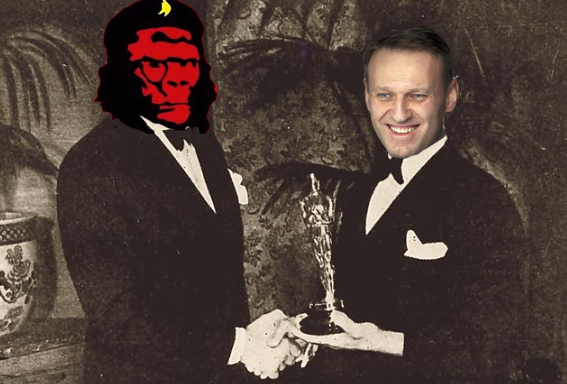

by John Helmer, Moscow
@bears_with
Since a pack of lies about Alexei Navalny (lead image, right) won last year’s Oscar for the best documentary film of the year when he was alive, there’s no doubt he can win another Oscar when he’s dead. But alive or dead, the prize-winning propaganda of Navalny’s story bears no resemblance to the truth. This is what happens in wartime, especially when the side which is losing the war on the battlefield – that’s the US, NATO and the Ukraine – claims to be winning the war of words against Russia.
The Navalny story is now in two parts: Part 1, the Novichok in his airport cup of tea, in his hotel water bottle, and then in his underpants which causes Navalny’s collapse, but fails to be detected by Russian doctors in Omsk, by German doctors in Berlin and Munich, and then by Swedish and French state laboratories. Part 2, Navalny’s sudden death after he had taken a walk in the IK-3 penal colony in the village of Kharp, in the Russian Arctic region of Yamalo-Nenets. The first part took 62 reports in this archive to expose the faking; the most telling evidence of this came from Navalny himself in the documented tests of his blood, urine and hair. According to these data, Navalny’s collapse was the outcome of an overdose of lithium, benzodiazepines, and other drugs.
Part 2 of the Navalny story began last Friday, February 16, with the Federal Penitentiary Service (FSIN) announcement, followed by an official telegramme to his mother in Moscow, that he had died just after two in the afternoon, Yamalo-Nenets time; that was just after noon Moscow time. Two hours later the Russian media began carrying the official announcement. The wording of the last line of the announcement is significant. “The causes of death are being established”, the FSIN statement said. Causes — plural.
In the UK coroner’s court practice, what this means is that there is likely to have been a sequence of causation, medically speaking, with the first or proximate cause of death identified as heart, brain, or lung injury or failure; and the second, intervening or contributory cause of death such as biochemical factors, including prescription drugs in lethal combination; mRNA anti-Covid vaccination triggering fatal blood clots; or homicidal poisons. For example, in the case of the alleged Russian Novichok death of Dawn Sturgess in England in 2018, the evidence is of British government tampering with the post-mortem reports to add Novichok when it wasn’t identified at first.
In Navalny’s case, poisoning on the order of President Vladimir Putin has already been announced as the cause of Navalny’s death without evidence at all. The delay time required for the complicated processes of forensic pathology and toxicology to establish the evidence has been reported in the Anglo-American media to signify cover-up and body snatching. Meduza, an oppositionist publication in Riga, reports that “a doctor who advised Navalny’s associates” has said that blood clotting was “an unlikely cause of death” – this is medically false.
In speculation of poisoning as cause of death, there is at least as much likelihood that Navalny, his team, and their CIA and MI6 handlers devised a repeat of the August 2020 Tomsk operation; decided when Navalny met with his lawyer at the prison on February 14; but implemented two days later without the resuscitation Navalny himself was expecting.
The Anglo-American propaganda warfare army is already pronouncing the contributory Cause 2– Putin did it — as the cause of Navalny’s death. If the Russians announce the proximate Cause 1 as cardiac arrest or brain aneurism, without a Cause 2, they won’t be believed. In the short term, Cause 2 cannot be established with credibility in Russia since it took the British government ten years, 2006-2016, to fabricate their story of Russian polonium poisoning in the Alexander Litvinenko case. In the Russian Novichok cases in England, it has so far taken six years of court, police and pathologist proceedings, 2018-2024, without outcome, and another two years will follow.
The problem for readers to interpret what has happened is that the Anglo-American propaganda warfare machine is better at what it does than the Russian side. But then when it comes to war with guns, not words, the Russian side is far superior, as can be seen in the Ukraine right now. Accordingly, the Kremlin has decided to concentrate on the main fight. Inside Russia, it has been obvious for a long time that in or out of prison, Navalny alive was politically insignificant; now even less. The new western propaganda is as ineffectual for Russians as Navalny was himself.
And so the purpose of the propaganda is different. President Joseph Biden’s statement on Navalny’s death makes this clear. “This tragedy reminds us of the stakes of this moment. We have to provide the funding so Ukraine can keep defending itself against Putin’s vicious onslaughts and war crimes. You know, there was a bipartisan Senate vote that passed overwhelmingly in the United States Senate to fund Ukraine. Now, as I’ve said before, and I mean this in the literal sense: History is watching. History is watching the House of Representatives. The failure to support Ukraine at this critical moment will never be forgotten. It’s going to go down in the pages of history. It really is. It’s consequential.”
For the German blood and urine proof of Navalny’s lithium and benzodiazepine addiction, start here and here. For the evidence from testing of Navalny’s hair, click.
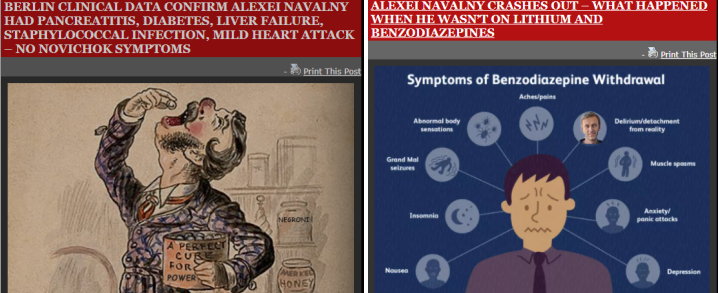
The scientific research indicating the blood-clot risk from the coronavirus mRNA vaccines is summarized in many places; for example, here.
The medical consensus on the risk of combining benzodiazepines with other drugs through liver enzyme failure and fatal tachycardia has been documented here. Russian doctors typically prescribe a benzodiazepine called Grandaxin (tofisopam in the west) for reducing bipolar mood swings, diffuse anxiety, and panic attacks. If combined with a sedative also commonly prescribed in Russia for sleeplessness and branded as Teraligen (alimemazine), the risk of liver enzyme failure leading to heart attack is not as well known as it is in the US and UK, and not monitored by regular liver testing. Navalny, his family, and his organization have never acknowledged his prior medical conditions, nor the medications he has been taking. To date, however, they have made no complaints against the Federal Penitentiary Service for depriving Navalny of the medicines he has requested. It remains to be seen whether the family or the prison service releases these personal data now.
Listen to the Gorilla Radio discussion with Chris Cook, recorded over sixty minutes on Sunday morning Moscow time, February 18:
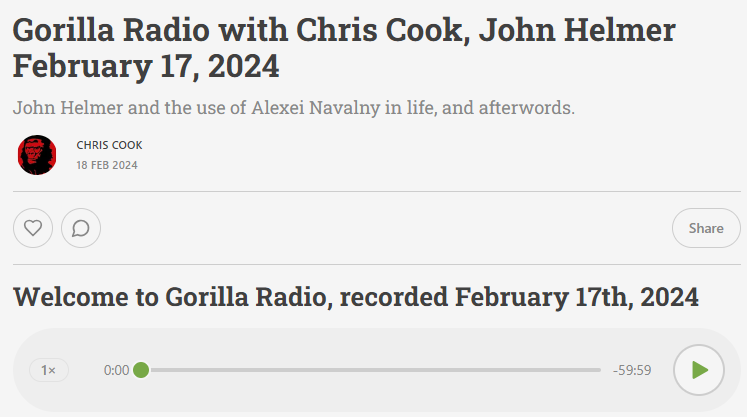
Click on link to listen: https://gradio.substack.com/
There is a notable difference between the US and NATO leaders on what happened to Navalny. In the wording Biden read out in his press conference, he said: “make no mistake — make no mistake, Putin is responsible for Navalny’s death. Putin is responsible.” When pressed by a reporter to clarify “was this an assassination?” the president said: “The answer is, I — we don’t know exactly what happened, but there is no doubt that the death of Navalny was a consequence of something that Putin and his — and his thugs did.”
The innuendo of murder does not (repeat not) appear in the statements by the French, German and British leaders.
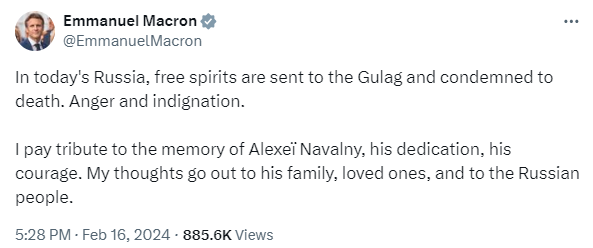
Source: https://twitter.com/EmmanuelMacron/

Source: https://www.bundeskanzler.de
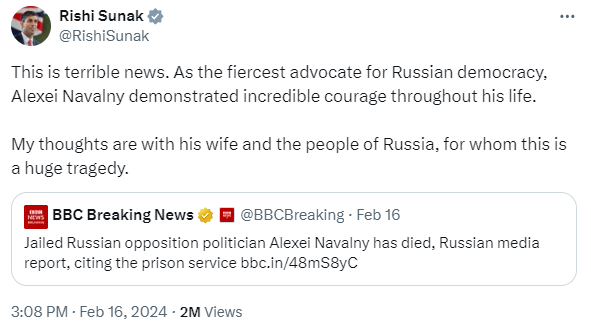
Source: https://twitter.com/RishiSunak/
The most loyal among the small allies of the US were also reluctant to repeat Biden’s claim and followed the French and British lead instead. Their remarks indicate the US is failing to hold its front against the Russians.
Canadian government leaders were circumspect on the cause of Navalny’s death; the one Canadian exception was Bob Rae, the former Ontario premier and currently Canadian representative at the United Nations. Rae tweeted: “Putin murdered #Navalny just as surely as if he’d strangled him with his bare hands.”
The Australian foreign minister, Penny Wong, stopped short of charging homicide, but imitated Biden: “We hold the Russian Government solely responsible for his treatment and death in prison.”
The New Zealand government was more cautious. Foreign Minister Winston Peters told reporters Navalny’s death was “untimely…Our thoughts are with his family and loved ones.” Prime Minister Christopher Luxon tweeted he was “saddened to hear of Russian opposition leader Alexei Navalny’s death. He was a fierce advocate of freedom and anti-corruption.” When pressed by a reporter, Luxon added that he might talk to the Russian ambassador.











Leave a Reply